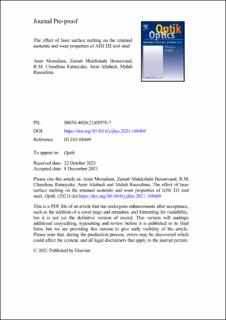| dc.contributor.author | Moradiani, Amir | |
| dc.contributor.author | Beiranvand, Zeinab Malekshahi | |
| dc.contributor.author | RATNAYAKE MUDIYANSELAGE, Chandima | |
| dc.contributor.author | Aliabadi, Amir | |
| dc.contributor.author | Rasoulinia, Mehdi | |
| dc.date.accessioned | 2023-02-17T15:27:14Z | |
| dc.date.available | 2023-02-17T15:27:14Z | |
| dc.date.created | 2021-12-12T09:46:29Z | |
| dc.date.issued | 2021 | |
| dc.identifier.citation | Moradiani, A., Beiranvand, Z. M., Ratnayake, R. C., Aliabadi, A., & Rasoulinia, M. (2022). The effect of laser surface melting on the retained austenite and wear properties of AISI D2 tool steel. Optik, 252, 168469. | en_US |
| dc.identifier.issn | 0030-4026 | |
| dc.identifier.uri | https://hdl.handle.net/11250/3052098 | |
| dc.description.abstract | In this study the effect of laser surface melting (LSM) on the amount of retained austenite, hardness and wear resistance of AISI D2 steel was investigated utilizing hardness test, X-ray diffraction (XRD), pin on disk wear test and scanning electron microscopy (SEM). In order to evaluate wear resistance, pin on disk tests at two different loads were carried out on surface treated samples including as received annealed and a quenched and tempered specimen. Surface treatment has been carried out in three different conditions; LSM, LSM with pre-heating at 300 °C and LSM with pre-cooling in liquid nitrogen which resulted in 64, 42% and 90% of retained austenite respectively, revealing that higher cooling rate led to a higher amount of retained austenite. The results showed that in spite of the presence of austenite as major phase in re-melted surface, the hardness reached to the values of up to 600 HV10 which is approximately two times of the as received steel having a lot of carbides dispersed in the ferrite matrix. In addition, at lower load, conventionally heat treated sample exhibited better wear resistance, whereas at higher load, the wear rate of laser melted specimen was the least as a result of the transformation of retained austenite into martensite. At lower load the dominant wear mechanism was abrasion while Adhesion was identified as the main wear mechanism at higher load. | en_US |
| dc.language.iso | eng | en_US |
| dc.publisher | Elsevier | en_US |
| dc.title | The effect of laser surface melting on the retained austenite and wear properties of AISI D2 tool steel | en_US |
| dc.type | Peer reviewed | en_US |
| dc.type | Journal article | en_US |
| dc.description.version | acceptedVersion | en_US |
| dc.rights.holder | The owners/authors | en_US |
| dc.subject.nsi | VDP::Teknologi: 500 | en_US |
| dc.source.journal | Optik (Stuttgart) | en_US |
| dc.identifier.doi | 10.1016/j.ijleo.2021.168469 | |
| dc.identifier.cristin | 1967383 | |
| cristin.ispublished | true | |
| cristin.fulltext | postprint | |
| cristin.qualitycode | 1 | |
